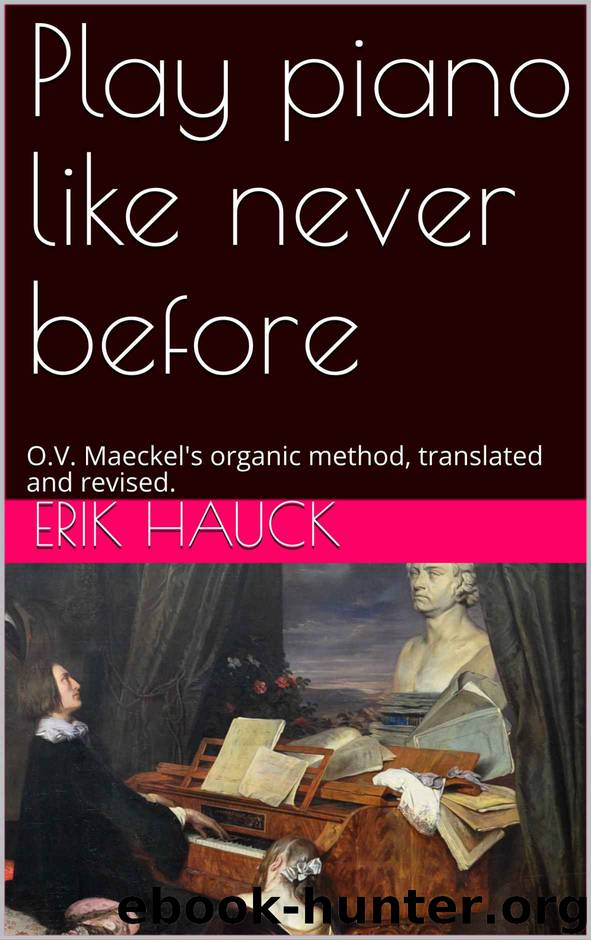Play piano like never before: O.V. Maeckel's organic method, translated and revised. by Erik Hauck

Author:Erik Hauck [Hauck, Erik]
Language: eng
Format: epub
Publisher: UNKNOWN
Published: 2017-04-09T07:00:00+00:00
II Striking several piano keys simultaneously
The melodic chords
I believe there are 2 types of chords. The first type of chords has a full, uplifting and singing sound. The second type simply serves to add harmonic structure. Let’s focus on the first kind: A melodic chord represents a cluster of several tones. Each one individually has to be played in a singing tone - simultaneously. We have already learned how to play a singing tone by itself in three different ways. Now we have to just understand which way is suitable to produce multiple singing tones in one chord. It takes only little thought to immediately recognize that the first option (the creepy crawling) cannot be considered. We cannot apply either the concept of the normal tone or the little finger movement. Further, the second option (the probing) cannot be applied to chords as well. It would not be practical to let more than one finger ‘snap’ forward. Thus, only the third option remains (butterfly wing flea). Indeed, it is used for the chords. You can see here already the melodic chords are generated through an active hand motion originating from the wrist. This circumstance leads me to the following preliminary thoughts.
No one lesser than Liszt has always claimed and taught with great emphasis that there is no other way to bring about chords so full and uplifting as if they are played only from the wrist, without active involvement of the arm. You may want to compare what is stated in the book “Franz Liszt as teacher, diary pages by Auguste Bossier” (Paul Zsolonay publishing) on page 56 and 59. This instruction by Liszt has not been followed much, often not even by his own students, and certainly not by today’s pianists, who almost without exception use the entire arm to produce chords. Some critics went as far as claiming this would be proof of how little Liszt actually knew about his own technique. A world renowned pianist, a friend of mine and still younger pianist had once attempted to convince me by demonstration that the massive chords in Tchaikovsky’s b-minor concert could never be played following Liszt’s instruction – in vain. I had to reassure him time and again that I had never heard these chords as massive and dramatic as during a performance by Sophie Menter (who he had already missed). She played those only from the wrist, without visible arm motion. Sadly, at that time, I was unable to perform myself what I tried to explain. I had not discovered the solution to the problem at that time. The solution, however, is something that Liszt himself never described in detail. Without it the chord would sound simply dull or hard. Again, it is the accelerated speed of the key depression. This can only occur if originating at the wrist. If the elbow or even the shoulder joint would be used as pivoting point, the lever would be way too large to create a differentiated acceleration of the finger tip over the distance of the height of the key.
Download
This site does not store any files on its server. We only index and link to content provided by other sites. Please contact the content providers to delete copyright contents if any and email us, we'll remove relevant links or contents immediately.
The Goal (Off-Campus #4) by Elle Kennedy(13542)
Kathy Andrews Collection by Kathy Andrews(11726)
Diary of a Player by Brad Paisley(7487)
What Does This Button Do? by Bruce Dickinson(6133)
Assassin’s Fate by Robin Hobb(6127)
Big Little Lies by Liane Moriarty(5699)
Altered Sensations by David Pantalony(5043)
Pale Blue Dot by Carl Sagan(4907)
Sticky Fingers by Joe Hagan(4100)
The Death of the Heart by Elizabeth Bowen(3551)
The Heroin Diaries by Nikki Sixx(3492)
Beneath These Shadows by Meghan March(3261)
Confessions of a Video Vixen by Karrine Steffans(3241)
How Music Works by David Byrne(3184)
The Help by Kathryn Stockett(3082)
Jam by Jam (epub)(3020)
Harry Potter 4 - Harry Potter and The Goblet of Fire by J.K.Rowling(2984)
Strange Fascination: David Bowie: The Definitive Story by David Buckley(2797)
Petty: The Biography by Warren Zanes(2697)
